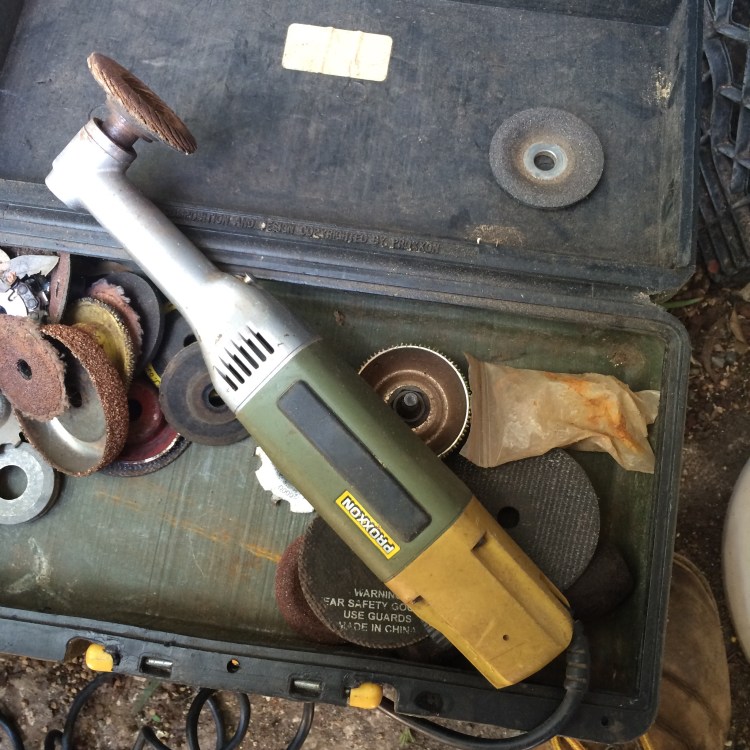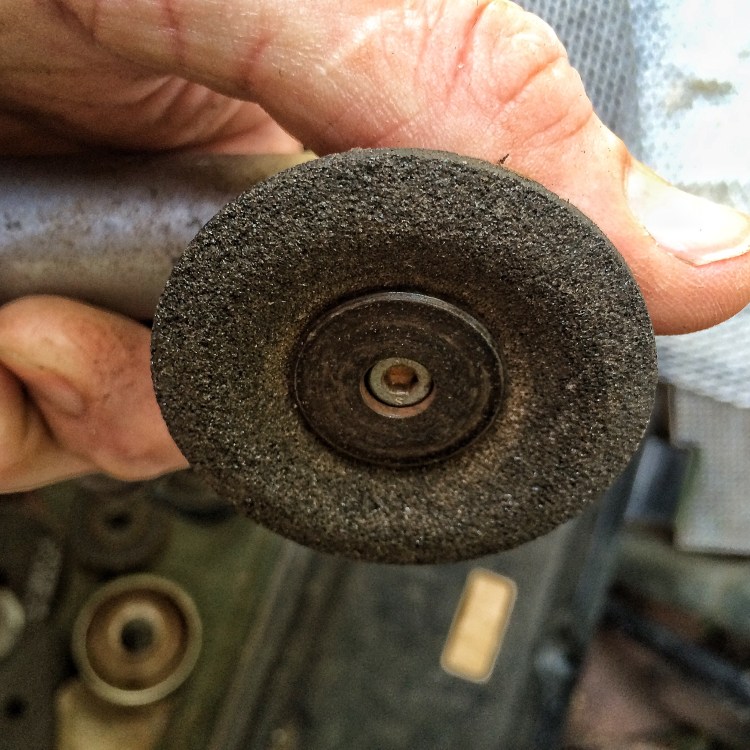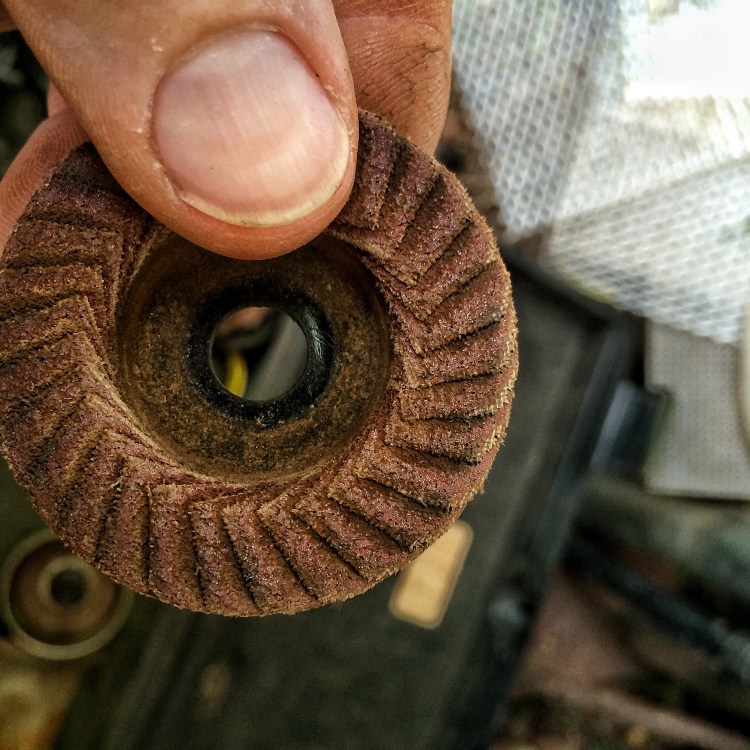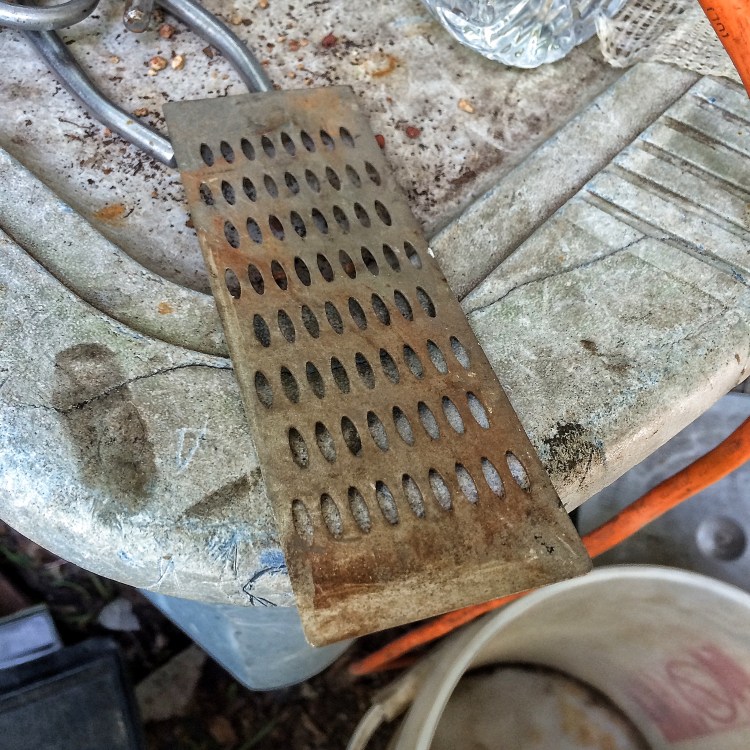Here’s a short post that might help you out, but is really just to make myself look more awesome. Because I am you know, just ask anyone. Unless your name is Mike. For some reason, all my life anyone named Mike just couldn’t appreciate my magnificence. Or they did in the beginning, but something happened that dissuaded them from the true and righteous path that I follow.
A tool. No, I don’t mean the Mikes of the world, but a bonsai tool.

Being the hoarder I am, I won’t throw it away. I shall attempt to repair it. And with what shall I fix it, dear Liza, dear Liza? Why, with my mini angle grinder, that’s what I’ll use.
 I have two wheels I’m using: a regular grinding wheel….
I have two wheels I’m using: a regular grinding wheel….

And a flap disc, which is comprised of overlapping layers of sand paper.
 This might be 150 grit. I’m not sure.
This might be 150 grit. I’m not sure.
Then, after all the grinding and smoothing, I will turn to a diamond card to sharpen it.
 This one is a medium grit I believe.
This one is a medium grit I believe.
Let me get to work. First is grinding it so that the tips are even.



Next, to address the chipped cutting edge.

For this I switch to the flap disc.

 That was the easy part. Now I have to fix the geometry. Firstly, the cutting edges should be parallel. Secondly, one cutting edge should overlap the other. No, really, they shouldn’t meet but one slides over the other. If they didn’t, the first time you used it, and the edges met, they’d blunt themselves.
That was the easy part. Now I have to fix the geometry. Firstly, the cutting edges should be parallel. Secondly, one cutting edge should overlap the other. No, really, they shouldn’t meet but one slides over the other. If they didn’t, the first time you used it, and the edges met, they’d blunt themselves.
The edges look good but the angles they were originally ground at no longer meet because I’ve removed material.

This pic shows the gap better.
 Now it’s a matter of grinding down the edges to match, a little on both sides. But, since I’m doing that, I’ll need to grind down the detante as well.
Now it’s a matter of grinding down the edges to match, a little on both sides. But, since I’m doing that, I’ll need to grind down the detante as well.

That little knobby thing is to keep the tool from deflecting too much when the cutting edges do meet.

A little sharpening and I’m done.


It’s not perfect but it’ll do. Please don’t take the brand the tool is as an example of a tool that may break like this. In fact, any tool with a hard enough cutting edge that is also sharpenable is also inherently brittle. It’s just the way metal works.

Thank you for this post. I have been working on this trying to sharpen my concave cutters. but I’d have a gap between the cutting edge. Then I had to file down the detante as well. I think this post will help keep me keep cutters sharp and last longer. Do you recommend a certain type of sharpening stone that doesn’t cost a fortune?
LikeLike
I recommend a diamond impregnated, steel sharpening card. They don’t wear out like a real stone and they are thin. Thin enough to get between the cutting edges.
LikeLike
Thank you. Are they available at local hardware stores or from special Bonsai sites?
LikeLike
They are available anywhere you can get sharpening supplies. A good brand is Dia-Sharp
LikeLike
Reblogged this on BONSAI WALES.
LikeLike
Good work, I’ve done similar with my tools when problems happen. BTW Japanese tools are typically hardened to Rockwell 65-68 meaning they value better edge taking but lower ductility meaning they will chip more readily but have longer lasting edges. Western tools typically are Rockwell hardness 58-60, meaning their makers y value durability over super keen edge. Steel types, alloys and forming process all matter too. But in general with all other things being equal the hardness difference harder is less ductule.
BY the way, be careful grinding, if the metal gets discolored you will have to re-temper the tool.
LikeLike
Thank you Rob. Interesting. My tools aren’t expensive and the metal does seem to be soft when I put a stone to them. Someday maybe I’ll invest in a better set of tools depending how well I learn this art.
LikeLike
Good tools can last if taken care of. I like stainless steel as I invariably forget a tool outside and it rusts to oblivion in a short order.
PS Sorry for my lousy typing
LikeLike
Reblogged this on Wolf's Birding and Bonsai Blog.
LikeLike